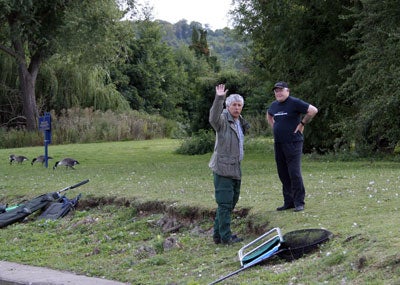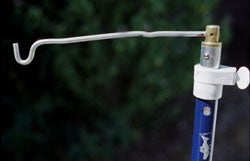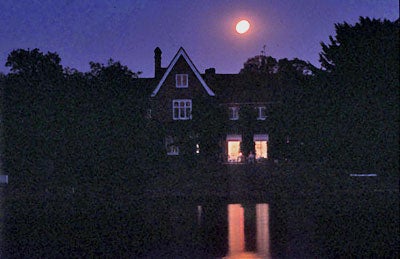Blanking
Not much to write about this month because since last month, quite frankly, I have not caught anything to write about. That doesn’t mean ‘anything substantial’, it does literally mean ‘nothing at all’, not a sprat, or minnow, or gudgeon, or bleak.
It means – no fish whatsoever!
I have suffered so many blanks now that quite honestly, I have lost all confidence in myself. This is no joke! This is what can happen to many anglers and they quit the sport for good, never to return to fishing. In other sports this doesn’t happen quite the same. Golf, for example, you might suffer the occasion few bad rounds, but at least you are still hitting a ball. In fishing, you can’t ‘hit’ a bite if you don’t get the bite in the first place.
Is it my fault? Have I changed something in my methods that now doesn’t work? Well that’s what I thought and so I stepped back and returned to old methods, the methods and the baits that others are catching on and yet still nothing. I have now reached the conclusion that this is a curse, someone has made a little image of me and is doing something unspeakable with it. I suspect everyone!
  Graham to Martin, “Put your hand up and get Woody Blanker to stay up there then we might have a chance.” |
It’s getting around that even my nickname has changed by adding ‘Blanker’ to my existing nickname. I have overheard the other anglers saying when I arrive, “Here’s that Woody Blanker again.” This is very embarrassing and I am desperate now to see the back of this curse and what’s more, it touches on other people I am fishing with. Ask Graham.
Jeff’s right, I hadn’t blanked too often for ages and then when I went to fish with Jeff on the Compleat Angler weir on the Thames with Frank Guttfield and Martin Salter, we all blanked! The day before and the day after, fishing sans Jeff, Frank, a regular on the weir, caught a few nice barbel, and I’ve done OK since. – Graham
Night Fishing
So for this month, I’ve dug out some pictures that were taken 12 years ago to explain some tips on night fishing. These were taken in the days when we were catching over 100lb bream bags through the night. They were on slide film and Mr. Marsden kindly converted them with his scanner, but if you think they are lacking in quality then it’s my fault and not Graham’s scanner. They are not the best of the pictures I took at the time as most were ‘lost in the post’ apparently some years ago when I sent them to a publisher, but hopefully they might convey the general idea.
  The positioning of the rods |
This was how we practised fishing the feeder on big wide rivers like the middle Thames at night. The positioning of the rods is similar to day fishing (see pic) except that, unless necessary, the rod isn’t kept so high. The idea of positioning yourself and the rod to face downstream is so that you can put a bow in the line between your rod tip and the feeder. This helps reduce drag on the line and allows you to fish with a lighter feeder than would otherwise be possible.
  The layout of tackle |
You will notice in another picture, the layout of tackle. This keeps a walkway clear between your seat and the rod tip so that you avoid treading on any valuable gear and breaking it. The area too is well lit with a storm lamp suspended from a bracket fashioned from an old aluminium rod rest top. The bank stick holding it is sunk into the water to keep it out of the way (striking is in the other direction) and to put the correct angle on the beam of light. This belts out the equivalent of 100 watts and is plenty to see the tip by and for unhooking fish in the walkway area near the lamp. Keeps the rats at bay also.
  Lamp bracket |
The first problem sceptics will raise is the brightness of the lamp. Well, because it is stationary it doesn’t scare the fish, certainly not where you are fishing, which can be 70 or 80 yards away. It certainly doesn’t scare the pike, usually the shyest of creatures, as many is the time a small roach I have been pulling in has been savaged by a predator hiding just below the light. You’ll probably find that a bright fixed light scares fish a lot less than a weaker head lamp that keeps moving around especially if it only comes on when a fish is caught or to re-bait.
At the other end of the rod there’s a target board to see the quiver tip against. In recent years it has become popular practise to use Starlights or Isotopes on the rod, but watching not the tip itself, but the shadow of the tip (remember putting the light at the right angle) against the white target board is far better. Certainly it shows up far more sensitive bites with movements of just 1 or 2 millimetres registering up to 1 inch of shadow movement on the board. This is another reason for using the bright storm lamp, but why doesn’t any manufacturers make target boards like this? (Perhaps a job for Tart Tackle!).
  Target board – Note the shadow from the quivertip |
So now you can see what you’re doing, where you’re walking, and even the bites. How do you know where you’re fishing? As in daylight, try to pick out a feature on the opposite bank that you can cast to throughout the night. For obvious reasons, not a swan or another angler who may move, and make sure it’s something that you can see as the hours of darkness wear on. Don’t be fooled by the lights on in the windows opposite, what happens when the occupants go to bed?
That’s gets the direction, what about distance? The reflection perhaps of the far bank marker if it’s a still night and the wind tends to die a little at night time, especially if the breezes are caused by the convection of warm air through the day. If something can be seen in the water it will give a clue as to how far out you are baiting and casting. Other than that, the length of time it takes a bait to land on the water can give a good indication, usually to a few yards and a good shoal of bream can spread over quite a lot of yards of river.
  Far bank marker |
In my favourite spot we had Bisham church directly opposite and I tried always to cast for the reflection of the point of the front door, which could be clearly seen even on moonless nights. I figured that the front door was hung in 1785 and if it hadn’t moved in that many years, it was hardly likely to move overnight. In another swim a few yards further upstream, I would cast to a particular tree and judged the distance from the time the feeder was in the air for. I knew the instant I had cast too far or not far enough.
Fed them Up
Feeding is important, but for bream it pays to put in a load of groundbait before night falls. This you can do with a groundbait catapult and a bucketful of mashed bread or breadcrumb. It can add some flavourings, Sensas Bream 3000 (colour not so important at night) for example or fishmeal, but plain bread will work just as well. You must put lots in over a slightly wider area where there are big shoals cruising around.
Hookbait was always either red or white maggot, although why colour should make a difference at night I don’t know unless there is also a flavouring with reds, and redworm. Sometimes a cocktail of the two would work and sometimes, just the redworm on its own. Bream can be very fickle (I wonder which famous angler wrote that?) so if bites die off, try a change of bait or hook size or even something simple like two maggots rather than three.
If you fancy giving night feeder fishing a go, take care please, but following some of the advice I have given here will stand you in good stead. I never had an accident either personally or to my tackle nor have any of my mates who fish the same way so some of what I’m saying is sound. If your club bans night fishing on the river then shame on them for there is hardly anything more exciting than night fishing at distance.
A Change of Luck?
Since starting this article I have been fishing in the late evening and just the other night … I CAUGHT A FISH!
  HP Sauce – “you’ll catch on that,” says Graham, who has now moved on to something even more secret……. |
A Barbel of around 8lbs, but no photographs since I didn’t take the camera with me for that is a curse, definitely. I can also only guess the weight since I never put the fish on the scales nor on an unhooking mat. In fact, it never even left the water. I just unhooked it, let it recover nicely and pretty quickly it was ready to swim away again. I believe it was a faster return because the fish never got air around its gills, it was always in water and that makes a big difference.
Anyway, what was the magic bait, you may ask. I have been joking with our Mr Marsden for some time about his propensity to put a famous make of brown sauce all over his breakfast. It must be a Northern thing as a fight nearly broke out once at Tesco’s cafe in Banbury when they didn’t have any brown sauce with the other condiments. The northerners were most upset so recently I invested in a small bottle to see if I too could acquire the taste, but when I told Graham, he said (jokingly I’m sure) that he also uses it as his ‘secret’ boily dip.
So that’s it. I soaked some of my old boilies in it and that’s what caught the fish. It’s as cheap as chips (and nice on chips too, I would imagine) with a big squeezy bottle costing less than £2 and available at all supermarkets and corner grocers. The secret bait dip is … HP SAUCE!
Maybe next time I’ll try an alternative brand for the Daddy’s of all barbel. Do you think that would be OK? I’ll say no more except…… Cheerio for now.
| JEFF WOODHOUSE |
|
Jeff caught his first fish at the age of five, a mackerel from a Torquay fishing boat. That was the starting point 53 years ago and the sight of that living silvery image coming up from the invisible depths had him hooked for life. Since then he has practised virtually every type of fishing, although not always successfully. He doesn’t just like fish, he has a love affair with them, in his living room, in his garden and at times, in his freezer. Lately he has spent more time either running clubs or assisting them to become successful. Now he admits to being too old to chase monsters, he’s happier getting as much fun as possible out of what’s before him. In this monthly series Jeff indulges the rebel within himself, often controversial and always trying to think differently about the usual trends in fishing. |













